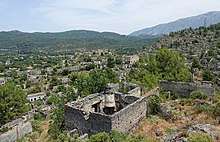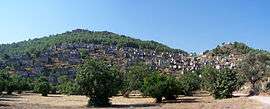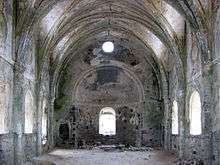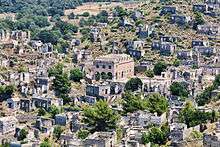Kayaköy
Kayaköy, anciently known in Greek as Karmilassos, shortened to Lebessos (Ancient Greek: Λεβέσσος) and pronounced in Modern Greek as Livissi (Greek: Λειβίσσι), is presently a village 8 km south of Fethiye in southwestern Turkey in the old Lycia province. From Ancient Greek the town name shifted to Koine Greek by the Roman period, evolved into Byzantine Greek in the Middle Ages, and finally became the Modern Greek name still used by its townspeople before their final evacuation in 1923.
 Abandoned houses at Kayaköy | |
 Shown within Turkey | |
| Alternative name | Lebessos, Livissi |
|---|---|
| Location | Muğla Province, Turkey |
| Region | Lycia |
| Coordinates | 36°34′29.94″N 29°5′27.94″E |
| Type | Settlement |
| Site notes | |
| Condition | In ruins |
In late antiquity the inhabitants of the region had become Christian and, following the East-West Schism with the Catholic Church in 1054 AD, they came to be called Greek Orthodox Christian. These Greek-speaking Christian subjects, and their Turkish-speaking Ottoman rulers, lived in relative harmony from the end of the turbulent Ottoman conquest of the region in the 14th century until the early 20th century, when the rise of nationalism led to persecution of minorities within the Ottoman realm and the eventual creation of modern Turkey by the Turkish National Movement.
The massacres of Greeks and other Christian minorities in the Ottoman Empire during World War I (1914–1918) led to the almost total depopulation of the town's 6,500 Greek inhabitants by 1918. These former inhabitants were bereaved of their properties and became refugees in Greece, or they died in Ottoman forced labour battalions (cf. Number 31328, an autobiography by a Greek-speaking novelist from a similar coastal town in Turkey).
Following these events the Allied victors in World War I authorized the occupation of Smyrna, which still had many Greek inhabitants, by Greece in May 1919. This led to the Greco-Turkish War of 1919–1922, the subsequent defeat of Greece, and the Treaty of Lausanne in 1923. That treaty contained a protocol, the Population exchange between Greece and Turkey, which barred permanently the return of any prior Greek Orthodox refugees to their homes in Turkey (including the previous Livissi refugees) and required that any remaining Orthodox Christian citizens of Turkey leave their homes for Greece (with an exception for Greeks living in Istanbul).
The treaty also required that Greece's Muslim citizens permanently leave Greece for Turkey (with an exception for Muslims living in Greek Thrace). Most of these Turks/Muslims from Greece were used by the Turkish state to settle its now empty Greek Christian towns, but Turks/Muslims from Greece did not wish to settle in Livissi due to rumors of ghosts of the Greeks killed there.[1]
The ghost town, now preserved as a museum village, consists of hundreds of rundown but still mostly standing Greek-style houses and churches which cover a small mountainside and serve as a stopping place for tourists visiting Fethiye and nearby Ölüdeniz.

The village is now empty except for tour groups and roadside vendors selling handmade goods. However, there is a selection of houses which have been restored, and are currently occupied.
History

Much of what remains of Livissi was built in the 18th century. Lycian style tombs can be found in the village and at Gokceburun, north of the village.
Lebessus is mentioned as a Christian bishopric in the Notitia Episcopatuum of Pseudo-Epiphanius composed under the Byzantine Emperor Heraclius in about 640, and in the similar early 10th-century document attributed to Emperor Leo VI the Wise, as a suffragan of the metropolitan see of Myra, the capital of the Roman province of Lycia, to which Lebessus belonged.[2] Since it is no longer a residential bishopric, Lebessus is listed by the Catholic Church as a titular see.[3]
Livissi is probably the place where the inhabitants of Byzantine Gemiler Island fled to protect themselves from pirates. It experienced a renewal after nearby Fethiye (known as Makri) was devastated by an earthquake in 1856 and a major fire in 1885. More than 20 churches and chapels were built in the village and the plain (Taxiarhes – the 'Upper' church – and 'Panayia Pyrgiotissa' – the 'lower' church – St. Anna, St. George, etc.). Most of them are still standing in ruinous or semi-ruinous condition. The village population was over 6.000 people, according to Greek and Ottoman sources.
The persecutions of Livissi inhabitants as well as Greeks of nearby Makri (Fethiye) were part of the wider campaign against all Ottoman Greeks and other Christians of the Empire (cf. Armenian deaths in World War I). The persecutions in the area started in 1914 in Makri. In 1916, a letter in Greek addressed to Sir Alfred Biliotti, the Consul General of Great Britain at Rhodes, explained the murders and persecution of Livissi and Macri Greeks who asked him for intervention. Unfortunately, the letter was intercepted at Livissi by Turkish authorities. Later that same year, many families of Livissi were deported and driven on foot to Denizli, around 220 km away. There, they suffered various extreme atrocities and tortures, facing even death.[4]
Two more exile phases followed in 1917 and 1918.[5] In 1917, families were sent in villages near Denizli, such as Acıpayam, through forced march of fifteen days, consisting mainly of the elderly, women and children, who had remained in the area. During that death march, the roads were strewn with bodies of dead children and the elderly who succumbed to hunger and fatigue. The exiles of the next year were no less harsh.
At the start of the Greco-Turkish War (1919–1922) Kayaköy was already nearly empty of its former inhabitants. When this war ended in September 1922, the few remaining Greeks of Livissi and Makri were forced to abandon their homes and embark on ships to Greece. Some of them founded the refugee settlement of Nea Makri (New Makri) outside of Athens.
Many of the town's empty buildings were damaged in the 1957 Fethiye earthquake.
Kayaköy today
Today Kayaköy village serves as a museum and is a historical monument. Around 500 houses remain as ruins and are under the protection of the Turkish government, including two Greek Orthodox Churches, which remain the most important sites of the ghost town.[6][7] There is a private museum on the history of the town. In the middle of the village stands a fountain that dates from the seventeenth century.
Some sources claim that Kayaköy was adopted by UNESCO as a World Friendship and Peace Village. However this is officially untrue, and was most likely a rumor put out by a local tourist council.
On 9 September 2014, the Turkish government announced plans to develop the village. It plans to offer a 49-year lease that will "partially open Kayaköy's archeological site to construction" and anticipated "construction of a hotel, as well as tourist facilities that will encompass one-third of the village."[8]
Economy
Villagers were mostly professional craftsmen. Currently the most important economic factor of the place is tourism. It is envisaged that the village will be partially restored.
Inspiration

Kayaköy is presumed to be the inspiration behind "Eskibahçe", the imaginary village chosen by Louis de Bernières as the setting of his 2004 novel Birds Without Wings.
In 2014, Kayaköy also took centre stage in the closing scenes of Russell Crowe's film The Water Diviner.
See also
References
- Elizabeth Warkentin. "Turkey's religious ghost town". Retrieved 26 December 2017.
- Heinrich Gelzer, Ungedruckte und ungenügend veröffentlichte Texte der Notitiae episcopatuum Archived 7 October 2016 at the Wayback Machine, in: Abhandlungen der philosophisch-historische classe der bayerische Akademie der Wissenschaften, 1901, p. 539, nº 280, and p. 555, nº 343.
- Annuario Pontificio 2013 (Libreria Editrice Vaticana 2013 ISBN 978-88-209-9070-1), p. 915
- Greek Genocide Resource Center. "Livissi (Kayaköy) and Macri (Fethiye)". Retrieved 26 November 2017.
- Persecution and Extermination of the Communities of Livissi and Macri (1914–1918). Imprimerie Chaix, Rue Bergère, Paris 1919. p17
- kayakoy.info. "Kayaköy History". Archived from the original on 9 February 2010. Retrieved 17 October 2009.
- The Independent (11 June 2005). "The Idyllic Town that Time Forgot". Retrieved 17 October 2009.
- Hurriyet Daily News. "For rent from Culture Ministry: Fascinating ghost town and bargain cultural heritage". Retrieved 11 September 2014.
- Abandoned Kayaköy a symbol of war's painful consequences, Hurriyet Daily News, Monday, 18 October 2010
- Kayaköy panoramic image December, 2012
External links
| Wikimedia Commons has media related to Kayaköy. |

- Some 200 pictures
- The Persecution of the Greeks of Livissi and Macri